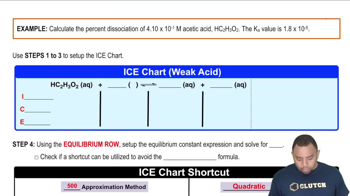Here are the essential concepts you must grasp in order to answer the question correctly.
Equilibrium Constant (Kc)
The equilibrium constant (Kc) is a numerical value that expresses the ratio of the concentrations of products to reactants at equilibrium for a given reaction at a specific temperature. A small Kc value, like 1.2 × 10⁻⁴², indicates that the reaction favors the reactants (H2) over the products (H atoms), suggesting that at equilibrium, the concentration of H atoms will be very low compared to H2.
Recommended video:
Equilibrium Constant Expressions
Dissociation Reaction
A dissociation reaction involves the breaking apart of a compound into its constituent elements or simpler compounds. In this case, H2(g) dissociates into 2H(g). Understanding this reaction is crucial for calculating the concentrations of H atoms at equilibrium, as it directly relates to how the initial concentration of H2 influences the formation of H atoms.
Recommended video:
Percent Dissociation Example
Stoichiometry
Stoichiometry is the calculation of reactants and products in chemical reactions based on the balanced chemical equation. In this scenario, the stoichiometric coefficients indicate that one mole of H2 produces two moles of H atoms. This relationship is essential for determining the molar concentrations of H atoms and H2 in the system, allowing for accurate calculations of their quantities at equilibrium.
Recommended video:
 Verified step by step guidance
Verified step by step guidance

